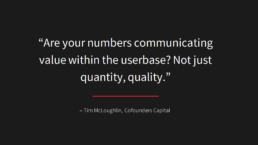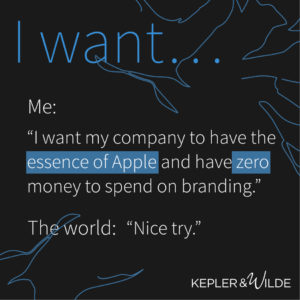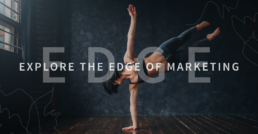How to Pivot Your B2B Event Marketing Strategy and Still Hit Your Numbers
How to Pivot Your B2B Event Marketing Strategy and Still Hit Your Numbers
As events continue to cancel and the coronavirus mandates remote work, many are wondering, in a climate of uncertainty, how can we pivot our marketing efforts and still stay on track to hit our numbers. Whether you’re relying on conferences or a traveling roadshow of dinners and lunch-n-learns to hit your OKRs, there are steps you can take to mitigate the abundance of cancellations to come.
Here are a few tips to calm the nerves and include in your presentation to leadership. (Because you know, your CEO will ask, if they haven’t already, to put together a deck outlining your event contingency plan.)
Tip 1: If you are a conference sponsor, get creative and work with the conference on a virtual engagement plan.
Conferences are a critical component to creating awareness, building your contact database and, ultimately, lead generation for your sales team. If you have invested in sponsorship, you are all in and expect to see ROI. On the flip side, conferences need us right now as much as we need them. They need us to stay loyal, keep engaged, and do everything we can to help avoid attendance numbers nosediving when they can finally reschedule.
Contact your conference liaison and ask if they have are open to creating a virtual engagement alternative like a webinar, email marketing series, or social media campaign. You can still leverage the attendee list, provide quality content, and have a CTA matching your quarterly objectives. Remember, you never know until you ask!
Tip 2: Begin to reallocate funds to video and (prospective customer) contributor content.
Video is consumed 4x more than any other content. If you have the ability to reallocate funds to video content creation this is the time to do it. Depending on your current customer journey needs, it may be time to beef up that product video, create compelling customer testimonials, or conduct a series of thought leadership interviews with prospective clients.
If you have the inclination to start bombarding your leads and prospects with more phone calls or lunches, don’t. Every other company has the same inclination and your leads’ already overflowing inboxes will become saturated with salespeople. To stand out and get your emails answered, try a different approach — ask your future or current customers to contribute to your content. Put them on your podcast, interview them for a video or blog. The goal here is to keep everyone engaged and much as possible so the sales cycle doesn’t stall.
Tip 3: To all of my marketers, support sales as much as possible.
As a marketer, I know the pressure to pivot and still perform in this climate is daunting. You have to find a way to supplement mass awareness and speaking engagements with digital marketing efforts. This is why I emphasize, realign yourself with sales and understand what they need to keep going.
Look back at your campaign and content performance data and come to the table with what works and, more importantly, what doesn’t. Understand your sales team’s expected event metrics and figure out what you can produce to help move them virtually move the needle. Support may come in the form of more case studies, sales decks, smart content, more sophisticated and targeted email drip campaigns, or more engaging webinars with longer live Q&As. Whatever it is make sure your copywriters are well caffeinated, graphic designers are on call, and MarTech is up for the challenge. This is the time when marketing automation needs to thrive and start working like a well-oiled machine.
Please comment and contribute! Let us know how your company is pivoting and the steps your marketing department is taking to keep sales stable.
The Marketing Data Every Founder & Investor Needs
We've compiled 5 types of marketing data every founder and investor should have in their back pocket.
This year, Kepler & Wilde’s CEO, Christy Harner, and CMO, Tara Fusco, had the pleasure of speaking at Seed the South during Charlotte Innovation Week.
Our team presented: Demystifying Numbers, The Marketing Data Every Founder Needs to Know!
Download the exact presentation presented at the event and learn how to:
- Uncover meaningful KPIs
- Communicate quality user metrics over quanity
- Avoid numbers that will only lead to smoke screens and inaccurate projections.
Bonus: We also cover marketing budgets and customer advosiry board data!

“This session covered everything! From product data to adoptability and overall marketing spend, I now know what I can bring to the table to communicate value and engage customers.” – Charlotte Start-up Fintech Founder
Ebook | 2020 The Year of the Channel Partner
You are tasked with developing a channel partnership program and execution plan, now what?
With scalable revenue and measureable ROI always top of mind, we realize you must look to partnerships to support the necessary and continuous touchpoints your customers need to engage, convert, and become champions of your brand. That is why Kepler & Wilde has officially deemed 2020 to be the year of channel partner.
This ebook will show you…
- How to Choose a Channel Partner
- How to Create a Shared Vision of Success
- Which KPIs to Consider
- How to Create the Content Your Partner Needs
- How to Develop a Customized Sales & Marketing Toolbox
DOWNLOAD THE EBOOK
“With clear objectives, team alignment, and the right toolbox, channel partnerships are a practical and profitable strategy that can lead to lower customer acquisition costs (CACs), increased lifetime value (LTV), and that elusive hockey-stick graph your investors keep itching to see.” – 2020: The Year of the Channel Partner
125 B2B Marketing Stats to Get You Started in 2020
125 B2B Marketing Stats to Get You Started in 2020
You read correctly, 125 B2B marketing, B2B content, B2B sales, and B2B digital stats. As we embark on a new decade, we have the unique opportunity to leverage years of marketing data, case studies, and real-world experiences to fuel future content creation, sales strategies, digital investments, and customer journeys for years to come.
The following statistics are great for practical implementation across your sales and marketing teams as well as guiding strategy and crafting budgets with key stakeholders.
So, sit back, sip your coffee, and enjoy 125 statistics that will empower your marketing team to hit the ground running in 2020!

B2B Marketing
- 80% of B2B buying decisions are based on a buyer's direct or indirect customer experience, and only 20% is based on the price or the actual offering. (CMO, 2019)
- 90% of B2B buyers now twist and turn through the sales funnel, looping back and repeating at least one or more task in the buyer's journey. (CMO, 2019)
- B2B industry professionals list lack of budget (59%) and the inability to reach the right people at the right time (39%) as their biggest obstacles (CMO, 2014)
- 52% of marketers say their company's ability to measure and analyze marketing impact is either sub-par or non-existent.
- Just 28% of marketers say they are "very effective" at demonstrating the value of their marketing efforts to their peers. The majority (69%) say that they are only "somewhat effective" at it. (KoMarketing, 2017)
- 96% of B2B buyers want content with more input from industry thought leaders. (Demand Gen Report, 2016)
- 73% of B2B buyers say they want a personalized, B2C-like customer experience. (Accenture, 2017)
- 71% of B2B buyers say customers increasingly want B2C-like experiences - faster response times and 24/7 availability-but nearly half (49%) say they're failing to deliver the personalized experiences their customers crave.
- 80% of U.S. marketers said they wanted to use integrated marketing and advertising technology from a single vendor. (Google, 2018)
- In the B2B setting, events help generate the most leads, while case studies help convert and accelerate the most leads. (Marketing Charts, 2018)
- 28% of marketing professionals have reallocated their traditional advertising budget to digital marketing. (Gartner, 2013)
- 50% of B2B Marketers see producing content consistently as a top content marketing challenge. (LinkedIn, 2015)
- 53% of B2B marketers have small or one-person content teams serving their entire organizations. (Content Marketing Institute, 2018)
- 69% of successful B2B marketers have a documented content marketing strategy. (Content Marketing Institute, 2019)
- The most successful content marketers have access to 40% of the total marketing budget, and the least successful have just 14% of the marketing budget. (Content Marketing Institute, 2018)
- More than half of all B2B buyers view at least eight pieces of content during the purchase process, and 82% of buyers viewed at least 5 pieces of content from the vendor prior to purchase. (Forrester)
- While over 30% of marketers think voice search is the next big trend, 60% have no strategy to incorporate it into their business strategy (EConsultancy, 2017)
- 1 in 3 B2B marketing professionals say finding new hires who are trained in content marketing is more challenging than ever (Content Marketing Institute, 2014)
- In 2015, 46 percent of B2B professionals are millennials (It’s now over 50%) (Think With Google, 2015)
- 34% of marketers are STILL not paying for their social media management tools (Advanced Web Ranking, 2017)
- 46% of all B2B researchers and buyers are millennials. (Google, 2015)
- Mobile drives or influences an average of more than 40% of revenue in leading B2B organizations. (Google, 2017)
- 50% of B2B search queries today are made on smartphones, and this percentage will grow to 70% by 2020.
- 86% of B2B marketers want to see products and services on a vendor's website home page, 52% want to see about/company information, 27% want to see testimonials, and 23% want to see marketing collateral. Details about technical support (59%) and pricing (43%) are also important to marketers. (KoMarketing, 2015)
- 69% of buyers indicated that "excessive form field requirements" would deter them from completing a contact form, with 65% stating they wouldn't submit a form if "too much personal information" was required. If the form included an automatic email subscription, 55% said that would deter them as well. (KoMarketing, 2015)
- 80% of business decision-makers favor getting brand information via an article series more than ads (Content Marketing Institute)
- 44% would like access to an ROI calculator for buying decisions.

B2B Content
- 91% percent of B2B marketers are doing content marketing. (Content Marketing Institute, 2018)
- 85% of B2B marketers say lead generation is their most important content marketing goal. (Ring Lead, 2017)
- For every $1 spent in email marketing, the average campaign earns $38 in ROI (Campaign Manager, 2016)
- Marketers see an average of 760% increase in revenue from customized, segmented email campaigns. (CampaignMonitor, 2017)
- 81% of businesses use video as a marketing tool (Experian, 2018)
- 96% of B2B companies plan to use video in their content marketing over the next year. (Social Media Today)
- 73% of B2B marketers say that video positively impacts marketing ROI.
- 70% of B2B buyers and researchers watch videos on their path to purchase.
- Infographic search volumes have increased by over 800% (Unbounce, 2012)
- 51% of B2B marketers prioritize creating visual assets as part of their content marketing strategy. (HubSpot, 2019)
- 86% of B2B companies maintain a blog (The Real-Time Report, 2010)
- 81% of businesses reported their blog as being critical to B2B lead generation. (Nurture)
- In a recent survey, over 40% of people admit they skim over blog posts (Hubspot, 2016)
- Blog posts with 6-13 word titles attract the most clicks (State of Inbound Report, 2017)
- Companies that blog 15 or more times per month drive 5x more traffic than companies that don’t blog. (Hubspot, 2016)
- 43% of B2B marketers say blogging is their most important type of content. (Social Marketing Industry Report, 2017)
- 29% of marketers repurpose existing content (Curata, 2016)
- The typical blog post is 1,050 words long. (Orbit, 2016)
- 48% of marketers are adding Youtube to their content distribution channel plan for the next year (State of Inbound Report, 2017)
- When an employee shares company content, their CTR is two times higher than if their company were to share the same content. (Ironpaper, 2017)
- 46% of B2B marketers say that professional quality photography is critical (CMO Council, 2016)
- 64% of B2B marketers hire freelancers to outsource writing projects. (Top Rank Marketing, 2014)
- The average person will only spend 37 seconds reading your article (Content Marketing Institute, 2016)
- Creative and personalized subject lines are 26% more likely to be opened than a generic phrase. (Experian, 2016)
- The leading reason business buyers have limited engagement with B2B vendors is because marketers are sending them too much irrelevant content (34%). (KoMarketing)
- 45% are looking for personalized content portals.
- 79% of B2B marketers credit email as the most effective distribution channel for demand gen efforts. (Content Marketing Institute, 2018)
- 32% say confusing content makes buying decisions more difficult.
- 90% of B2B marketers say the leading attribute of content marketing effectiveness is "audience relevance" (Statista, 2018)
- The top 2 technologies B2B organizations use to assist with content marketing are analytics tools (86%) and email marketing software (85%). (Content Marketing Institute, 2019)
- The average number of audiences B2B marketers create content for is 4. The average is higher in large companies (5) and lowers in small companies (3). (Content Marketing Institute, 2019)
- The top 3 types of content B2B marketers use are social media content (95%), blog posts/short articles (89%), and email newsletters (81%). (Content Marketing Institute, 2019)
- The five most engaging phrases to include in B2B post headlines on social media are "the future of," "X ways to," "need to know," "in the world," and "of the year." And keep them short: while the most engaging headlines for consumer posts run between 12 and 18 words, the most effective length for B2B headlines are in the five to 10-word range. (BuzzSumo)
- 76% of B2B marketers prioritize content quality over quantity. (Content Marketing Institute, 2018)
- 35% of B2B content marketers can measure ROI, 47% admit that they can't measure ROI and 18% aren't sure. (Content Marketing Institute, 2018)

B2B Sales
- The majority of senior executives (92%) own a smartphone used for business, with 77% reporting they use their smartphone to research a product or service for their business. While the majority (93%) go on to purchase that product via the Internet using a laptop or desktop, 50% of these executives have purchased IT products for business using their smartphone, with 13% reporting making a purchase between $1,000 to $4,999. (IDG Global Solutions)
- 68% of B2B companies have not identified their sales funnel. (Marketing Sherpa)
- 78% of executives say that an unsolicited email has led to a face to face meeting or event attendance at some point. (ITSMA, 2019)
- 62% of buyers say they can make a business decision based on online content alone. (2019)
- 49% of B2B marketers say articles are the most effective type of content for moving prospects through the sales funnel (Statista, 2017)
- Most B2B buyers are already 57% of the way through the buying process before the first meeting with a representative. (Accenture, 2018)
- B2B buying cycles are getting longer and more complex-58% of buyers said their decision process was longer in 2017 than in 2016; just 10% said purchase time decreased. Buyers are conducting more detailed ROI analysis before making a purchase decision (77%); using more information sources for research and evaluation (75%), and increasing the number of buying group members (52%). (Business2Community, 2017)
- 50% of LinkedIn users say they are more likely to buy from a company they interact with on LinkedIn. (Ironpaper, 2017)
- In 2017, it has been reported that 80% of B2B social media leads stem from LinkedIn (Ironpaper, 2017)
- 45% of marketers have gained customers through LinkedIn. (Quick Sprout)
- 65% of B2B companies have acquired a customer through LinkedIn paid ads. (HubSpot, 2018)
- LinkedIn is 277% more effective in generating leads than Facebook. (HubSpot, 2018)
- A new survey by Sacunas reveals 73 percent of millennials are involved in some aspect of purchasing decisions at their B2B companies; and at one-third of companies, a millennial is the sole decision-maker. (RDW Group, 2016)
- Mobile marketing can accelerate time to B2B purchases by 20%. (BCG, 2017)
- 80% of B2B executives research products or services on a tablet in the evening. (IDG Global Solutions)
- 57% of B2B marketers stated that SEO generates more leads than any other marketing initiative. (Junto, 2017)
- A personalized web experience can increase sales by 19% (MarTechAdvisor, 2018)
- B2B e-commerce sales are expected to outgrow B2C e-commerce sales by 2020. (Ecommerce Platforms, 2018)
- B2B e-commerce will exceed 12% of all B2B revenue by 2020. (BCG, 2017)
- 86% of buyers say they are "overwhelmed and annoyed" with more than 10 pieces of review content (BizReport, 2018)

B2B Digital
- 63% of marketers believe their biggest challenge is generating traffic and leads (State of Inbound Report, 2017)
- 36% of desktop users click on the first search result they see. (Advanced Web Ranking, 2015)
- 22% of smartphone owners worldwide use their device every 5 minutes (Advanced Web Ranking, 2017)
- 1 in 5 Smartphone Owners Worldwide Use Their Device Every 5 Minutes (“Always On – A Global Perspective of Consumer Mobile Experience” study, 2017)
- More than 1 in 3 people in Brazil use their mobile devices for over 6 hours a day. (Advanced Web Ranking, 2017)
- Over half (53%) of emails are opened on mobile devices. (Campaign Monitor, 2015)
- Digital channels matter most: 56 percent of millennials report search engines, vendor websites and social media are the most important sources of information when researching new products. (RDW Group, 2016)
- 58% of B2B marketers pay to advertise on search engines and believe it is the most effective paid method of digital marketing (Consalta)
- 94% of B2B marketers use LinkedIn for content distribution (Content Marketing Institute, 2015)
- 200 million people use ad-blocking technology (Content Marketing Institute, 2016)
- 76% of Facebook users visit every single day (Business2Community, 2017)
- More than 9 in 10 mothers are active on a social networking website or service (Edison Research, 2017)
- Professional SEO services are requested by almost 30% of all customers (Advanced Web Ranking, 2017)
- Even in industrial and manufacturing industries, 67% of purchases are influenced by digital (Google, 2019)
- Mobile usage per B2B worker is expected to increase from two hours a day to three by 2020, driven by millennials, Gen Z, and the increasing use of smartphones by older workers. (Google, 2017)
- 60% of B2B buyers report that mobile played a significant role in a recent purchase. (BCG, 2017)
- 80% of B2B buyers use a mobile device at work. (BCG, 2017)
- 70% of B2B buyers increased mobile usage significantly over the past two to three years, and 60% expect to continue to increase their mobile usage. (BCG, 2017)
- More than 90% of buyers say they're likely to buy again from a vendor that had a superior mobile experience, compared to 50% of those who report a poor experience. (BCG, 2017)
- 46% will leave a website because of a lack of message (it's not clear what the company does), and 37% will leave because of poor design or navigation. (MarketingProfs, 2015)
- 22% (11 out of 50) of the fastest-growing B2B companies have a live chat widget on their website. (Drift)
- 42% of companies have a mobile-optimized website (B2BMarketingZone, 2018)
- 44% of B2B marketers say the main reason they abandon websites is that there's no contact info immediately visible. (KoMarketing, 2015)
- IT, B2B, and wholesale companies have the weakest mobile email opens, while TV/radio/film, events, and real estate have the strongest mobile email opens. (Campaign Monitor, 2018)
- 59% of B2B marketers say SEO has the biggest impact on their lead generation goals. (Marketing Charts)
- Strategic landing pages are used by 68% of B2B businesses to acquire leads. (Marketo, 2018)
- 45% of enterprises are investing more than $20,000 on SEO each month. (B2BMarketingZone, 2018)
- 71% of B2B researchers begin their research with generic Google searches.
- 90% of B2B researchers who are online use search specifically to research business purchases. (Google, 2015)
- On average, B2B researchers do 12 searches prior to engaging on a specific brand's site. (Google, 2015)
- Only roughly 20% of the information on B2B websites out there displays characteristics of buyer enablement
- 84% of B2B marketers use paid distribution channels (like Instagram, LinkedIn, Facebook, YouTube, and more) for content marketing purposes. (Content Marketing Institute, 2019)
- 75% of B2B buyers use social media to support their purchase decision. (HubSpot, 2017)
- Only 47% of marketers say they are actively using LinkedIn. (HubSpot, 2018)
- Businesses on Twitter generate twice the amount of leads as opposed to those not on the platform. (HubSpot, 2018)
- Facebook (89%), LinkedIn (81%) and Twitter (75%) are the three most used social media channels by B2B marketers. Instagram is up and coming. (MarTechAdvisor)
- 33% of B2B businesses use Instagram.
- Nine out of 10 Americans worry about online privacy and data security. (Marketing Dive)
- 67% of all consumers have taken steps to defend their personal data, by limiting tracking or providing false information to companies. (Forbes)
- Brands that are upfront about how they use the information to target ads can boost engagement levels by up to 40%. (Marketing Dive)
- 75% of customers surveyed are more willing to share personal data with a brand they trust. (Forbes)
- The European Union’s General Data Protection Regulation (GDPR) is the most robust privacy protection law in the world to date. (Privacy Policies, 2019)
- In the U.S., all 50 states as well as Washington D.C., Guam, Puerto Rico, and all the U.S. Virgin Islands, have enacted laws that require businesses to notify consumers if their personal information is compromised. (Data Protection Online Report, 2019)
Explore the Edge of Marketing
Explore the Edge of Marketing
In our inaugural post, it seemed appropriate to headline our tagline, strip it down to the bare bones, and say hello world this is Kepler & Wilde.
What does this mean? This means, welcome to the edge. Some may describe it as cutting edge or bleeding-edge, but we at Kepler & Wilde focus on one thing, taking you to it, letting you look over, and empowering you to explore the possibilities of transforming the way you do, well — everything.
The edge is different for every organization, but here are a few of our favorite scenarios.
The classic B2B scenario.
Most B2B organizations claim they are investing in the latest digital marketing channels and content, but only 27% of the leads marketing passes over the wall will be qualified.
The Edge: Reevaluating lead qualification, the entire editorial calendar, and the infrastructure
[or lack thereof]
you have set up to align your sales and marketing teams. Think bringing an end to endless .csv email attachments, dirty data in Salesforce, improper use of marketing automation systems, sales sending assets with inconsistent branding, weekly meetings that provide little value to stakeholders, or worse KPIs that do not match organizational OKRs.
The edge is disrupting one dysfunctional environment to build a self-sustaining sales and marketing ecosystem focused on qualified leads, more wins, and continuously increasing customer LTV.
My marketing department is “data-driven”, but I can’t calculate ROI on SEO.
 You might want to brace yourself; you are about to get a taste of what Kepler & Wilde will be known for, the uncensored, unabashed truth. NEWSFLASH: for you data-driven is simply a buzzword, you’ve built a smoke-screen of 1’s and 0’s so you can buy time to figure out what you’re doing or hire the people that can. We believe you, you have A LOT of data, so much of it that it’s overwhelming and you don’t know what to do with it or what to pay attention to.
You might want to brace yourself; you are about to get a taste of what Kepler & Wilde will be known for, the uncensored, unabashed truth. NEWSFLASH: for you data-driven is simply a buzzword, you’ve built a smoke-screen of 1’s and 0’s so you can buy time to figure out what you’re doing or hire the people that can. We believe you, you have A LOT of data, so much of it that it’s overwhelming and you don’t know what to do with it or what to pay attention to.
It’s okay, believe me, you are not the only one. Did you know, 42% of B2B marketing executives say that can calculate the ROI of their marketing spend only some of the time, or not at all.
The edge: Revaluating your resources, auditing your marketing spend, and investing in the technologies that can help you work smarter. Ask yourself this: Do you have the in-house resources and tools you need to analyze the data you have. Do you know which channels are providing the lowest CPL? How are you notified of anomalies that could be marketing gold? That geofencing campaign you’re running, are those hits converting?
The edge is investing in the infrastructure you need to reduce waste and uncover untapped ROI.
I want my company to have the essence of Apple and have zero money to spend on branding.
Champagne taste on a beer budget. Start-ups you are not the only ones that fall into this well-known trap, corporations do it ALL. THE. TIME.
 Also, if you want to be like Apple, we hate to tell you – so does everyone else. Yes, you too can have a clean, minimalist style, but take it from our co-founder with 15 years of design experience – there’s so much more.
Also, if you want to be like Apple, we hate to tell you – so does everyone else. Yes, you too can have a clean, minimalist style, but take it from our co-founder with 15 years of design experience – there’s so much more.
As we approach the edge of brand development, consider this:
Start-ups we are talking to you: Have you proven product-market fit? Do you have a raw customer journey? Have you thought about your brand story, your purpose, mission, vision, core positioning? Is your brand ready to play in the big leagues?
The edge isn’t about the money, it’s about a state of mind. If you are ready to invest in your brand, don’t hire someone to design your logo, hire a team to tell your story.
Okay, companies making at least a million in revenue, here’s your stern talking to: If you’re questioning the look and feel of your brand, if you are finding inconsistencies in your social media images, pitch decks, or UI then it’s time to STEP UP YOUR GAME. This goes for B2B and B2C.
60% of millennial consumers expect a consistent brand across all channels. Millennials are now more than 25% of the population. They are purchasing BI software for your marketing department, and they make up 30% of retail sales.
The edge is your brand’s identity. If your brand is not emotionally connecting to the needs of your audience, then someone else is. Don’t get left behind, make the investment in an authentic, consistent, and relevant brand.
Keep going, don’t mind if we do…
We encourage you to sign up for our newsletter, it will be filled with semi-sarcastic witticisms on marketing and brand strategy, and heady articles you will actually read. Like the one you just so clearly enjoyed, as you have made it this far.
In the meantime, we would like to thank you for reading and, officially, welcome to keplerandwilde.com.




